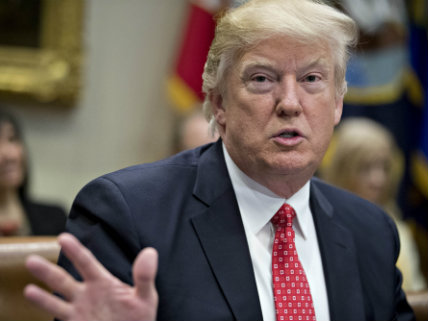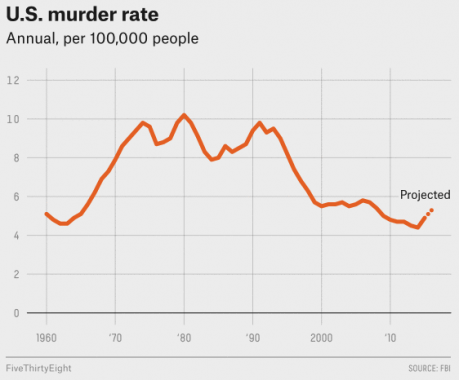Trump Says U.S. Murder Rate at Highest Level in 45 Years. That's Not Even Close to Being True
Even with the murder rate ticking upwards over the past two years, we are still at a level that's less than half of the peak murder rate over the past 45 years.

President Donald Trump on Tuesday claimed the murder rate in the United States is "the highest it's been in, I guess, 45-47 years."
"I'd say that in a speech and everybody was surprised because the press doesn't like to tell it like it is," Trump said during a morning meeting with law enforcement officials from around the country.
Yes, everyone should be surprised by that claim, but not for the reason the president suggested.
They should be surprised because it is completely false.
According to the FBI—which tracks crime statistics in the country, not "the media," as Trump suggested—the murder rate in the United States is near an all-time low. According to the FBI's 2015 crime report, there were 15,696 murders in the United States that year, which translates to a murder rate of 4.9 per 100,000 people.
That's the highest murder rate in six years, not 45 years.
In fact, even with the murder rate ticking upwards over the past two years, we are still at a level that's less than half of the peak murder rate during the past 45 years, according to the FBI's statistics, collected from more than 18,000 jurisdictions around the country.
Here's the facts. Forty-seven years ago, in 1970, the murder rate was 7.9 per 100,000 people. The rate climbed steadily throughout the 1970s and reached a peak of 10.2 per 100,000 people in 1980. Murder rates dipped throughout the mid-1980s before rising again at the end of the decade to a second peak of 9.8 per 100,000 in 1991.

From that second peak, the murder rate steadily declined until it reached a low point of 4.4 homicides per 100,000 people in 2014, before the uptick in 2015. Data for the full year of 2016 is not yet available, but statistics from the first half of 2016 suggest that the murder rate might have climbed again last year (though certainly not to levels that come anywhere near the peaks in 1980 and 1991).
The slight increase in violent crime during 2015 can be attributed mostly to seven urban areas—Baltimore, Chicago, Cleveland, Houston, Milwaukee, Nashville, and Washington, D.C.—that accounted for half of the national increase. It's not even true for Trump to argue that crime is increasing in cities, since only 25 of the nation's 100 largest cities saw an overall increase in violent crime in 2015, according to the FBI.
It's not just the murder rate that has fallen recently. All forms of violent crime are down 19 percent, and property crime fell by 23 percent, between 2008 and 2015.
Trump is wrong about this.
Still, being wrong about crime has helped fuel Trump's rise from reality TV star to leader of the free world.
At the Republican National Convention in July, Trump said the nation was experiencing "a moment of crisis" caused by "violence in our streets and chaos in our communities."
"Crime is out of control and rapidly getting worse," he tweeted in July.
And he's been spouting off about the murder rate being at a 45-year high since at least late October.
"We have the highest murder rate in this country in 45 years. You don't hear that from these people. They don't want to talk about it. The highest murder rate in the United States in 45 years," he said at a rally in Iowa on October 28, according to The Washington Post. He repeated the assertion the next day at an event in Phoenix and the day after that at a rally in Las Vegas.
As I wrote last week, many voters seem to share this misguided view that crime is reaching record levels. Polling data from Democracy Fund Voice, a nonpartisan organization that conducted a series of polls and sit-down interviews with voters during the final weeks of the 2016 presidential campaign, shows that 63 percent of all voters The numbers for people believing crime and believe crime is getting worse, while only 14 percent say it's getting better. Among self-identified Trump supporters, the gap was 79-8, compared to 51-21 for Clinton supporters. "Pretty much everyone believes it's gotten worse as a problem," says Patrick Ruffini, co-founder of Echelon Insights and one of the members of the Democracy Fund Voice research team.
Voters being ill-informed is nothing new, of course. More worrying is the fact that Trump, having used this story about rampant lawlessness to get himself elected, might actually believe the falsehoods he's been spreading and use this inaccurate picture of the nation's crime rates to implement policy.
Conway on POTUS false murder-rate claims: "He's relying on data, perhaps, for a particular area. i don't know who gave him that data"
— John Harwood (@JohnJHarwood) February 7, 2017
What might he do? Reason's Jacob Sullum has explained in detail why Trump's favored solution, "stop and frisk," makes no sense even in the cities where violence is on the rise. "Promiscuous use of that tactic, which involves detaining and patting down pedestrians who strike police as suspicious," Sullum wrote last year, "causes understandable resentment among the young black and Latino men who bear the brunt of it, and there's little evidence that it curtails violent crime."
On Tuesday, Trump indicated a willingness to target state lawmakers who have been standing up to law enforcement groups in an effort to reform civil asset forfeiture, a process by which the government can seize property from innocent civilians without convicting them of a crime (or sometimes without even getting an indictment). It's an element of law enforcement that screams for reform, since it creates a whole series of perverse incentives for cops.
Having a president stomp on those reform efforts in the name of "being tough on crime" would be bad for the country.
Still, If Trump wants to implement policies that will take the murder rate to a 45-year low (a very achievable goal, considering how close we already are to that point), he could scale back the federal war on drugs and legalize marijuana. That would help eliminate some of the violence caused by the black market for drugs—even though an accurate count is hard to pin-down, between 5 percent and 25 percent of all homicides are drug-related, according to the CDC.
None of this is to say that that crime isn't a serious problem in many places. We don't know yet whether the recent uptick in violent crime is a blip or an indication of a new trend. If the latter, perhaps policy changes will be necessary to extend the decades-long decline.
Those changes, if needed, should be implemented thoughtfully and—this should go without saying, but apparently it must be said—should be based on the reality of crime in the United States in 2017, not the fevered dystopian dreams of a reality television star.




Show Comments (95)